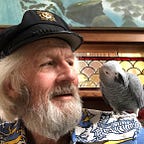Robinson Crusoe Island—a marooned writer, a movie, and more.
Pacific Voyages — Travel to Places You Will Never Go
Más a Tierra used to be the name of an island 400 miles off of Chile—until it was officially renamed “Robinson Crusoe Island” in 1966.
This is where Alexander Selkirk was marooned for four years and four months starting in 1704. Unlike Clipperton, the last island I reported on, this is a paradise. Selkirk survived on fruit, lobster, nuts, spices, goats, birds and eggs. What, no croissants?
In 1719 Daniel Defoe used the book Selkirk wrote about his adventure as the jumping off point for his book Robinson Crusoe. Some fans contend that this book is the first English novel. Wow. I should point out, though, that there about ten other contenders for the first English novel status such as Thomas Malory’s Le Morte d’Arthur written in 1470 (Hey, Tom, if you are going for the gold as first English novel why the French title? I cry foul!) The ‘first novel crowd’ is vicious and I’ll leave that fight to them….fight, fight!!! One thing not in dispute is that it has been one of the most frequently published books of all time and has never been out of print.
The 1958 movie is well worth your time if you can look beyond the idea that Crusoe was a skipper in the African slave trade. Hey, Lincoln had slaves, right?
Selkirk had a much more genteel trade. He was a pirate, the shoot-shoot stab-stab kind. And Selkirk’s ship didn’t sink as did Crusoe’s. He asked the pirate captain to be left ashore when they stopped to load water because he had grave (get it? grave, ha-larious) concerns that the ship unseaworthy. With a smirk, the captain said, ‘What evs, Alex.” The ship sailed away and promptly sank, the smirk quickly fading from the captain’s face. As is true today, the place was crawling with goats and Selkirk really did dress like the Crusoe illustrations always show — in all goat attire.
A passing English ship eventually picked up the castaway and the captain of that vessel reported in his memoirs that Selkirk was in remarkably good shape both mentally and physically.
Amazingly, the last naval engagement between the British and the Germans in the Pacific happened in front of San Juan Bautista, the Chilean village on Más a Tierra. What? There was a naval battle between the Brits and the Germans in the Pacific? Well, I guess so but no one told me. The sinking of the battleship Dresden marked the last of the German East Asian Squadron. This was in Chilean waters and Chile protested that the British were outta line with all this shooting in this neutral country’s waters. The British said get over it and here are 300+ German survivors if you’re so concerned. They remained in Chile for the rest of the war and many of their decedents are still there which is one reason southern Chile’s architecture is distinctly German.
Today about 700 people live on the island and it’s a minor tourist destination. You can actually dine at the mouth of the cave Alex lived in where a restaurant serves fruit, lobster, nuts, spices, goats, birds and eggs.
